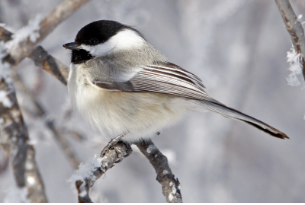February Kids’ Corner
from the Gale River Cooperative Preschool
Birds of a Feather-uary
Black-Capped Chickadee
While many birds spend their winters in warmer climates, there are some bold and well adapted feathered friends who stick around up here! Winter can be a great time to view birds. First, without leaves on the trees, it’s easier to spot birds or pinpoint their location after hearing them. Second, around here we can put out our bird feeders in the winter allowing the birds to come to us! Some of the most common birds you’ll see in winter include black-capped chickadees, blue jays, cardinals, white-breasted and red-breasted nuthatches, and sparrows. We also will see larger birds like turkeys, crows, grouse and ravens. Many of these birds have adaptations to withstand the winter cold. Chickadees can go into a controlled state of hypothermia at night, lowering their body temperature by 12-15 degrees and conserving energy! Larger birds like grouse will insulate themselves by growing extra feathers and many birds focus their diets around foods with fat that their bodies can burn to stay warm. Some birds like sparrows will find specific tree cavities or dense foliage to shelter in. They’ll huddle together for warmth and minimize heat loss by tucking in their heads and feet. Cardinals and chickadees will puff up their feathers to capture the warm air and insulate themselves better.
One of the best ways to help the birds hanging here all winter is to put up nutrient and fat rich bird feeders. Including black sunflower seeds, mixed seeds, safflower seeds, suet, and thistle will help cater to a wide variety of birds and their diets. It’s also fun and easy to make bird feeders by spreading a nut butter on pinecones and rolling it in seeds then hanging it outside. Whether you go searching for birds through binoculars or simply admire the ones that come visit your feeders, you have to give it up to these hardy creatures as they weather the winter with us.
Want tips on how to explore birds this February? Click here for ideas then head
Outside!
There are lots of bird identification apps that make it easy to figure out who you’re seeing on winter walks. Downloading merlin from the Cornell Lab of Ornithology will allow you to search possible birds through identifying characteristics or use sound ID to capture their call! Make sure you have this on your phone for your next winter hike and see who you can find!
Sketching or drawing pictures of what we’ve seen on a nature adventure is a great way to reflect! After a bird focused hike, work with the children to think about the shape of the birds’ bodies, the colors, the sizes, and have them try to draw what they saw! If they’re working on early literacy they can try to write the names too. Add a date and see how what you’re observing changes over the seasons.
Making bird feeders is a fun and easy way to help out your feathered neighbors. The materials you’ll need include pine cones or branches, a nut butter of your choice (such as peanut butter or sunbutter) string and bird seeds. First, attach your string to your wood or pinecone so you can hang it when you’re done. Next, slather it in your nut butter and roll it in seeds! Hang it up on a tree and see who comes to visit!
Paper plate birds. This craft is fun and easy! Simply fold your paper plate in half and draw on or attach feathers for wings and a tail. Add a construction paper beak and googly eye and some skewers for long feet. You can have them stand in a piece of clay or hang them up!





